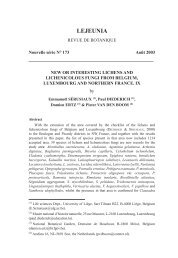The Lichens and Lichenicolous Fungi of Belgium and Luxembourg ...
The Lichens and Lichenicolous Fungi of Belgium and Luxembourg ...
The Lichens and Lichenicolous Fungi of Belgium and Luxembourg ...
Create successful ePaper yourself
Turn your PDF publications into a flip-book with our unique Google optimized e-Paper software.
THE LICHENS OF BELGIUM AND LUXEMBOURG. AN ANNOTATED CHECKLIST 17<br />
Fig. 7. Natural outcrops in the Meuse valley between Namur <strong>and</strong> Givet represent one <strong>of</strong> the<br />
most valuable habitats for lichens in the area <strong>of</strong> study. <strong>The</strong> Xerobromion communities in the<br />
Leffe valley near Dinant (upper photo), here photographed in spring when Hippocrepis comosa<br />
<strong>and</strong> Helianthemum apenninum are flowering, colonize the compact limestones <strong>of</strong> the<br />
Carboniferous (Visean); the lichen flora is very spectacular, with among others terricolous <strong>and</strong><br />
muscicolous communities with Fulgensia fulgens <strong>and</strong> Psora decipiens <strong>and</strong> very rare species<br />
like Placolecis opaca <strong>and</strong> Squamarina gypsacea. <strong>The</strong> rocks at Petit-Chooz near Givet (lower<br />
photo) are calcareous clayey schists belonging to the Upper Emsian (‘Grauwacke de Hierges’)<br />
<strong>and</strong> also are colonized by Xerobromion communities, here well characterized by the abundance<br />
<strong>of</strong> Artemisia alba, Potentilla rupestris, <strong>and</strong> Sempervivum tectorum. However, the lichen flora<br />
clearly marks the rapid decalcification <strong>of</strong> the rock surface, with the occurrence, within a<br />
phanerogamic vegetation dominated by calcicolous species, <strong>of</strong> Lecanora orosthea, Lecidea<br />
fuscoatra, Rhizocarpon lecanorinum, etc. <strong>and</strong> small cushions <strong>of</strong> Cladonia uncialis subsp.<br />
biuncialis. Photographs: E. Sérusiaux (1999).<br />
Les affleurements de rochers naturels dans la vallée de la Meuse entre Namur et Givet<br />
constituent un des habitats les plus précieux pour les lichens dans le territoire étudié. Les<br />
pelouses du Xerobromion dans la vallée de la Leffe près de Dinant (photo du haut), ici<br />
photographiées au printemps au moment de la floraison d’Hippocrepis comosa et<br />
d’Helianthemum apenninum, colonisent les calcaires compacts du Carbonifère (Viséen); la flore<br />
lichénique est très spectaculaire, avec notamment des groupements terricoles et muscicoles à<br />
Fulgensia fulgens et Psora decipiens, et des espèces très rares comme Placolecis opaca et<br />
Squamarina gypsacea. Les rochers de Petit-Chooz près de Givet (photo du bas) sont des schistes<br />
argileux calcarifères appartenant à l’Emsien supérieur (‘Grauwacke de Hierges’) et sont eux<br />
aussi colonisés par des pelouses du Xerobromion ici bien caractérisé par l’abondance<br />
d’Artemisia alba, Potentilla rupestris et Sempervivum tectorum. La flore lichénique marque<br />
cependant très bien la décalcification rapide de la roche, avec la présence, au sein d’une<br />
végétation phanérogamique dominée par les espèces calcicoles, de Lecanora orosthea, Lecidea<br />
fuscoatra, Rhizocarpon lecanorinum, etc. et des coussinets de Cladonia uncialis subsp.<br />
biuncialis. Photographies: E. Sérusiaux (1999).<br />
Natuurlijke rotsen in de Maasvallei tussen Namen en Givet zijn een van de meest waardevolle<br />
biotopen voor korstmossen in het onderzoeksgebied. In het dal van de Leffe bij Dinant<br />
(bovenste foto) wordt de harde kalksteen uit het Carboon (Viséen) bedekt door Xerobromionvegetaties,<br />
hier in het voorjaar gefotografeerd met bloeiende Hippocrepis comosa en<br />
Helianthemum apenninum. De grond- en mosbewonende korstmosvegetaties zijn zeer spectaculair<br />
met onder <strong>and</strong>ere Fulgensia fulgens en Psora decipiens en zeer zeldzame soorten als<br />
Placolecis opaca en Squamarina gypsacea. De rotsen bij Petit-Chooz bij Givet (onderste foto)<br />
bestaan uit kalkhoudende, kleiachtige schisten en behoren tot het Boven-Emsien (‘Grauwacke<br />
de Hierges’) en zijn ook gekoloniseerd door Xerobromion-vegetaties, hier gekarakteriseerd door<br />
het veelvuldig voorkomen van Artemisia alba, Potentilla rupestris en Sempervivum tectorum.<br />
Hoewel de hogere planten hier ho<strong>of</strong>dzakelijk kalkminnende soorten zijn, geeft de korstmosflora<br />
duidelijk een snelle ontkalking van het rotsoppervlak aan, met soorten als Lecanora<br />
orosthea, Lecidea fuscoatra, Rhizocarpon lecanorinum en kleine kussentjes van Cladonia<br />
uncialis subsp. biuncialis. Foto’s: E. Sérusiaux (1999).





